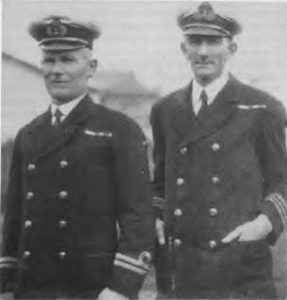- Author
- Jarrett, Hugh
- Subjects
- History - general, Biographies and personal histories
- Tags
-
- RAN Ships
- HMAS Parramatta II
- Publication
- December 1994 edition of the Naval Historical Review (all rights reserved)

Captain during the Great War
In 1925 our family packed and moved to South Australia where my father took up a new appointment as Sub-District Naval Officer, having transferred to the Naval Auxiliary Service, the main function of which was to train Reserve Officers and Ratings under the Compulsory Service Training Scheme. All fit young men were compelled to do training in the Citizen Forces.
The Reserve Training Depot was situated in Fletcher Road, Birkenhead, just across the river from Port Adelaide.
Port Adelaide was a very interesting place for small boys, and I have, many fond memories of the many trading ketches and schooners which carried wheat and wool from the many little ports across St Vincent’s Gulf; some working further afield. They had such names as EVALITA, HEATHER BELLE, WIAMANA, TICKERA, ONE AND ALL – to name a few. Now they are just memories, having been put out of business by motor transport. However, the name, ONE AND ALL, has been preserved by building a new vessel to remind posterity of a glory that is long past. Beside these trading vessels, there were a number of largish gaff-rigged fishing cutters which worked St Vincents and Spencer gulfs and Kangaroo Island waters. These were soundly built and very good seaboats that sailed very well indeed.
All these seafaring activities employed a large number of men with a good working knowledge of seamanship. A ready source of men for the Naval Reserve.
Fletcher Road had a strong naval association. Rather surprising, perhaps, when one considers the remoteness of Port Adelaide from the centres of naval affairs in New South Wales and Victoria. Prior to Federation, the Colony of South Australia had its own small navy with HMCS PROTECTOR as its proud fighting ship. It seemed many families in Fletcher Road were related to someone who had served in her, particularly on her trip to the Boxer Rebellion.
Naval Reserve Depots prior to 1939 were run on a shoestring when compared with the same establishments post 1945. The staff at Birkenhead comprised:
District Naval Officer: Commander or Lieut-Cdr.
Sub-District Naval Officer: Lieutenant
Junior Officers: 1 or 2 if available
CPO Instructors: About 6
Working hands: 6 Boatmen
Civil Staff: Chief Clerk, 1 or 2 clerks, 1 Typist
The unusual rank mentioned is `Boatmen’. These were mostly Permanent Service ratings on the Fleet Reserve who had opted to join the Auxiliary Service. They wore the old class 3 uniform – peaked cap with red badge, single-breasted uniform, white shirt with black tie.
The Boatmen performed all the duties necessary to run the depot, such as shipwright, armourer, clothing and naval storekeeping, various office tasks and keeping the place clean and tidy, which they did very well.
Although there was a Communications Branch CPO on the staff for Reserve training, all signals to and from the Depot where by GPO telegram which the Boatman, who carried out the duty of postman, collected at the Port Adelaide Post Office daily.
The establishment opened in the morning six days a week, and the ensign was hoisted punctually at 8 a.m. by the duty Boatman, but otherwise normal office hours were observed, except when there was a drill night – usually Tuesday nights. Saturday afternoons were taken up with boating and rifle shooting at the Port Adelaide Rifle Range.
As the State representative of the RAN, the District Naval Officer always was involved in Vice-Regal and other State functions, and on occasions ceremonial Guards of Honour were provided by the Reservists aided by the Bluejacket Band under the baton of Warrant Bandmaster Rodda.
The time came when the Navy built a very nice little brick bungalow at the rear of the Naval Depot and it was decided our family could live there. This meant moving from Largs Bay where we two boys had been at school and had made many friends. So we regarded the new home as a mixed blessing; we had acquired a large private playing field – the grassy parade ground – and there were many things to do, being thrust, as we were, into a training organisation with guns, flags, boats and sailors. But it was a mixed blessing, because our Largs Bay friends were now a couple of miles or more away and we had to walk the full length of Fletcher Road to get to the Largs Bay State School, although, it must be said the Le Fevre Peninsula State School was right next door to the Naval Depot. We lived inside the restricting influence of a tall corrugated iron fence outside of which lived whole tribes of Birkenhead kids of whom mother was none too keen, they being the sons and daughters of wharf labourers, seamen, fishermen and the unemployed. There is little doubt that they were a tough bunch. We were not permitted to encourage them. After all, the Navy did not want them running around inside the drill hall. Nevertheless we two got on with them quite well. Eventually I had to enroll at their school, Le Fevre Peninsula State, which had the reputation of being extremely rough. My father, with a certain amount of foresight, had D’arcy Lee, one of the Boatmen, who had been Fleet Welterweight Champion, give me boxing lessons. I found this very useful on the several occasions when I had to fight my way home.




